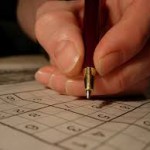THE MARGINS of Olga’s Sudoku digests are studded with little notes to herself, in tiny perfect penmanship. “Careless errors!” she might have rebuked herself. Or “Getting better — or are they getting easier?” Very little that Olga does escapes her own immediate and systematic appraisal. In the private moments of her own life she is her own coach, doling out approval or gentle criticism and making immediate tweaks to the process. In her bowling league, “When I get a strike, I take note of where I was standing and how hard did I throw it,” she says, “and then try to duplicate those conditions.”
Call it the Olga recipe for perpetual improvement.
Turns out, Nature has an app for that. On chromosome 11 sits a gene called DRD2 that is linked to the brain’s “reward” circuitry, and partly governs how we learn. Some people have a variant of this gene called RS 1800497, and those people tend to be good at learning from their mistakes. They are highly motivated to turn wrong answers into right ones, faulty lines of thinking into sound ones, lousy habits into good ones. Such self-renovation makes these people happy.
Olga was born with this gene variant. (And I, for what it’s worth, wasn’t.)
So that’s pretty cool, but also a little dangerous – because it not only undersells the work ethic of those who have that polymorphism, but it gets the rest of us off the hook.
The truth is, we can all learn to learn from our mistakes. And we must if we hope to appreciably improve.
Maybe you’ve heard of this fellow from Portland named Dan McLaughlin who’s trying to become a pro golfer starting from absolute zero. Until recently – he’s now in his late twenties – he was a commercial photographer. He’d never picked up a club before April 2010. He’s starting slowly and methodically; he’s only been using a full set up clubs since January of 2012. McLaughlin hopes to enjoy a kind of accelerated development through super-efficient practice — -time feedback and immediate review and adjustment and repetition. He has calculated, based on Anders Ericsson’s rule-of-thumb that it takes 10,000 hours of “deliberate practice” to become an expert at something, that he should theoretically be good enough to enter Q school by October of 2016.
Not all practice is created equal. Elite swimmers practice better than merely good ones. Ditto elite backgammon and poker players.
It’s qualitative, not quantitative, practice that matters. “A qualitative change involves modifying what is actually being done, not simply doing more of it,” noted sociologist Dan Chambliss in an academic paper called “The Mundanity of Excellence.” Elite swimmers don’t necessarily practice more than merely good swimmers, Chambliss noted, but they sure do practice better.
If the golfer Dan McLaughlin is motivated to practice better because he’s getting a late start, that goes triple for Olga.
Thinking about all of this made me remember Bruce Pandolfini, whom I spoke to a few years ago while working on a cover story for Psychology Today about the virtues of failing. Pandolfini is a chess teacher. In the movie Searching for Bobby Fischer, about a chess prodigy named Josh Waitskin, the kid’s master teacher, played by Ben Kingsley, is based on Pandolfini.
I dug out my transcript of my interview with Bruce. (If you want to really learn from people, tape the conversation and review it!) A revelation! There was in there all kinds of cool stuff I’d forgotten, just about all of it relevant to Olga and her self-correction strategy.
Losing is always more valuable than winning, Pandolfini told me – especially for younger players. Because it’s an opportunity for learning: a weakness was very specifically exposed, and now you can fix it. Whereas winning prompts all sorts of lazy habits. “Often students don’t realize how lucky they were to win. And because they won they didn’t think they had to change anything about their play. Then next time they played a superior opponent, and they played this same way, they’d get crushed.”
Great chess players are like two people in one — the person playing and the person analyzing the person playing. They develop the discipline of asking themselves a series of questions not just after every game but after every move. “Does this threaten me? How many possible ways can I deal with the threat? How well did my opponent deal with my previous move?” This forensic analysis happens at a higher speed than Olga – or most other mortals – can manage, but the principle of systematic review is the same.
All that review helps chess players develop spectacular memories for past moves in past games, good and bad – the better to apply those lessons in future.
Bruce remembered coming up against a strong opponent in a best-of-three series. In the first game he found himself in a tight spot that seemed vaguely familiar. He was, he realized, in the exact position he’d been in twenty years earlier, and back then he had escaped by deploying a trap he’d learned from Russian playbooks from the 1960s.
“And then I realized, as I looked up, I was facing the same player I’d played twenty years earlier.”
I guessed where this was going. Presumably a player of his opponent’s calibre would also have remembered being in this position, and remember the sting of losing, and this time would avoid that ignominy by making adjustments against Pandolfini’s ploy.
“Nope,” Bruce said. “He fell for it again.”
